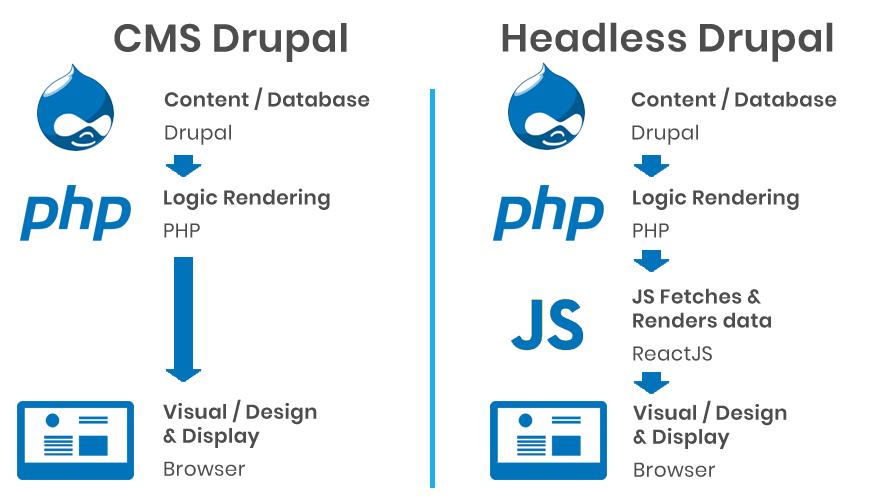

Followed by what kind of decoupled architecture. The first decision you should take is to choose between traditional and Decoupled. In essence, they are static pages with Javascript components that act through an API. It’s a combination of a fully decoupled static site and a decoupled site. Jamstack stands for Javascript, API, and Markup. JAMstack (JavaScript, APIs, Markup) can be used to work around the complexities of JavaScript development in developing fully decoupled Drupal static sites. While this architecture improves performance, security and reduces complexity, the downside is that even simple content changes should be followed up with the task of recompiling and publishing the complete website. Fully Decoupled apps do not have a few functionalities such as in-place editing and layout management, but the method is quite popular among the developers (who use Angular, React, Vue.js, etc in building applications) because they have much greater control over the front-end module. HTML/CSS/JS files are used to store content in the framework. On the other hand in a fully decoupled static site, the front-end is completely built into a framework. The Fully decoupled Drupal can be implemented in two ways, namely Fully decoupled app and Fully decoupled static site.Ī fully decoupled Drupal web app involves a complete separation of concerns between the presentation layer and all other aspects of the CMS. In the beginning, in fully decoupled architecture Drupal was just a CMS that provides data, and a JavaScript application with server-side rendering manages the entire rendering and markup while communicating with Drupal via web service APIs.Ībout a few years back this architecture branched into two separate paradigms due to the increasing complexity of JavaScript development. This option suits an organization that is committed to delivering regular content on their website or needs the content (such as price, job openings or images, features, products specifications, etc) regularly. The Javascript ensures that the layout and other user experiences are retained or not disturbed much while the content is being updated.
HEADLESS DRUPAL UPDATE
It means the editors can take better administrative capabilities and change, edit or update the content easily. The difference in control lies with its commitment to JavaScript, the lesser the page committed to the JavaScript the lesser the dependency on developers. JavaScript is responsible for rendering a single block or small portion of a page or it may render an entire page. This method is called progressively decoupled Drupal.

When you have to deliver highly interactive interfaces with enriched user experience, then you use an additional JavaScript layer on top of the front end drupal making it headless/decoupled. There is also an accessible version of this flowchart described in words by one of drupal’s founders. Let us understand the different methods or options to decouple drupal. In a world where brands are on a constant run in creating an omnichannel experience, Drupal presents itself in various formats to meet various expectations of an organization and to balance the needs of content editors and website developers. Decoupled Drupal is one of the best-known tools to meet those soaring expectations of customers in terms of content presentation, user experience, and consistency across devices. Also, websites need to keep the layout, experience, and branding consistent irrespective of the device it is being accessed. Let us understand Decoupled Drupal (Headless Drupal) from A to Z.Įvery website does more than just display content, a website is a medium through which unique and experiential content is consumed, and presented to the consumer.

Decoupling Drupal allows the developers to create future-ready applications that can be hosted on various channels, and also allows for a faster user request-response time. Often considered as an ultimate tool for implementing a divided backend content and feature-rich front-end interface, Decoupled Drupal has inherent innovative strength to produce exceptional digital experiences. Decoupled Drupal refers to a Drupal architecture where Drupal’s back-end exposes content to other front-end systems, essentially serving as a central repository of content that can be served to a wide variety of devices.


 0 kommentar(er)
0 kommentar(er)
